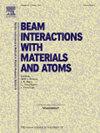IGCAR的场发射扫描电子显微镜(i4-FESEM)设备的原位离子辐照和成像
IF 1.4
3区 物理与天体物理
Q3 INSTRUMENTS & INSTRUMENTATION
Nuclear Instruments & Methods in Physics Research Section B-beam Interactions With Materials and Atoms
Pub Date : 2025-06-02
DOI:10.1016/j.nimb.2025.165759
引用次数: 0
摘要
我们最近在Kalpakkam的英迪拉甘地原子研究中心(IGCAR)建立了一个名为“现场离子辐照和成像场发射扫描电子显微镜(i4-FESEM)设施”的新设施。该现场离子辐照和成像设施是印度首个此类设施。该装置是将一台高分辨率场发射扫描电子显微镜(FESEM)与1.7 MV对撞机加速器的10°光束线相结合而建立的。采取了许多措施来有效地隔离光束线到FESEM的机械振动。这种原位设置使得监测具有亚微米尺寸的单个特征或结构的演变成为可能,作为离子影响的函数。这种设置可以在预先确定的离子影响间隔内进行顺序照射和扫描电镜观察。我们通过跟踪在2 MeV Si+离子照射下硅衬底上单个金纳米颗粒的位移以及通过跟踪沉积在蓝宝石衬底上的锑岛来证明其性能。本文章由计算机程序翻译,如有差异,请以英文原文为准。
In situ ion irradiation and imaging with field emission scanning electron microscope (i4-FESEM) facility at IGCAR
We have recently established a new facility named ‘in situ ion irradiation and imaging with field emission scanning electron microscope (i4-FESEM) facility’ at Indira Gandhi Centre for Atomic Research (IGCAR), Kalpakkam. This in situ ion irradiation and imaging facility is the first of its kind in India. This facility is established by integrating a high resolution Field Emission Scanning Electron Microscope (FESEM) with the 10° beamline of 1.7 MV tandetron accelerator. Many steps were taken to effectively isolate mechanical vibrations from the beamlines to the FESEM. This in situ setup makes it possible to monitor the evolution of individual features or structures with submicron dimensions as a function of ion fluence. This setup enables sequential irradiation and SEM observation at predetermined intervals of ion fluence. We have demonstrated its performance by tracking the displacement of individual gold nanoparticles on a silicon substrate upon 2 MeV Si+ ion irradiation and by tracking islands of antimony deposited on sapphire substrate.
求助全文
通过发布文献求助,成功后即可免费获取论文全文。
去求助
来源期刊
CiteScore
2.80
自引率
7.70%
发文量
231
审稿时长
1.9 months
期刊介绍:
Section B of Nuclear Instruments and Methods in Physics Research covers all aspects of the interaction of energetic beams with atoms, molecules and aggregate forms of matter. This includes ion beam analysis and ion beam modification of materials as well as basic data of importance for these studies. Topics of general interest include: atomic collisions in solids, particle channelling, all aspects of collision cascades, the modification of materials by energetic beams, ion implantation, irradiation - induced changes in materials, the physics and chemistry of beam interactions and the analysis of materials by all forms of energetic radiation. Modification by ion, laser and electron beams for the study of electronic materials, metals, ceramics, insulators, polymers and other important and new materials systems are included. Related studies, such as the application of ion beam analysis to biological, archaeological and geological samples as well as applications to solve problems in planetary science are also welcome. Energetic beams of interest include atomic and molecular ions, neutrons, positrons and muons, plasmas directed at surfaces, electron and photon beams, including laser treated surfaces and studies of solids by photon radiation from rotating anodes, synchrotrons, etc. In addition, the interaction between various forms of radiation and radiation-induced deposition processes are relevant.

 求助内容:
求助内容: 应助结果提醒方式:
应助结果提醒方式:


